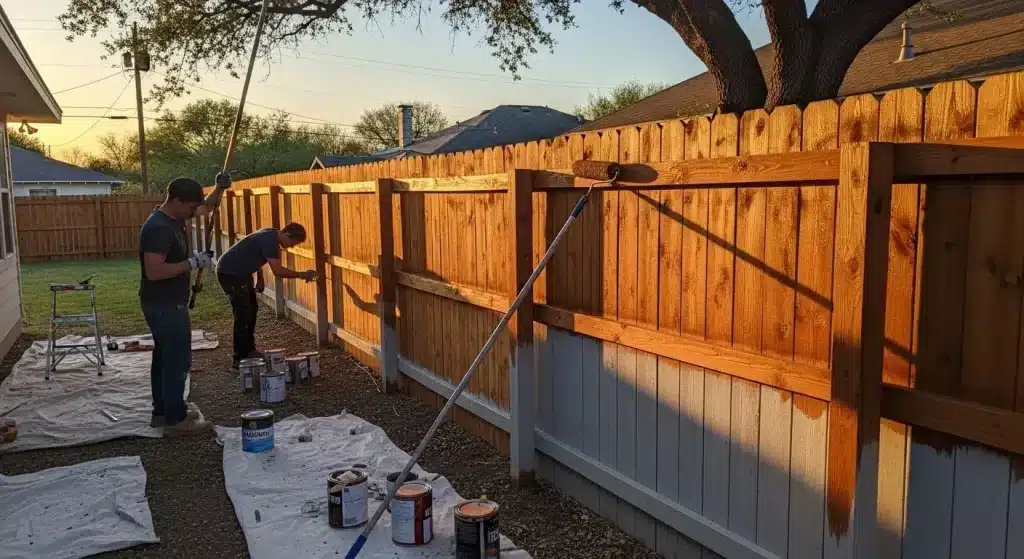Differences Between Fence Staining and Painting in Austin TX Explained

When homeowners in the Austin area consider protecting and beautifying their outdoor fencing, they often face a crucial decision: should they choose staining or painting? Understanding the fundamental differences between fence staining and painting in Austin TX is essential for making an informed choice that will serve your property well in the challenging Texas climate.
Austin’s unique weather patterns, including intense summer heat, sudden temperature fluctuations, and occasional severe storms, create specific demands for fence protection. The choice between staining and painting can significantly impact both the appearance and longevity of your fence investment. Elevate Painting has observed countless Austin homeowners struggle with this decision, which is why understanding these differences is so important.
The decision between fence staining and painting in Austin TX goes beyond simple aesthetics. Each approach offers distinct advantages and challenges that must be weighed against your specific needs, budget, and long-term maintenance preferences. Whether you’re dealing with a new cedar fence in Westlake or an aging wooden fence in East Austin, the right choice can mean the difference between years of low maintenance and frequent touch-ups.
Understanding Fence Staining and Painting in Austin TX Climate Conditions
The Austin metropolitan area presents unique challenges for exterior wood protection due to its distinctive climate patterns. Summer temperatures regularly exceed 100 degrees Fahrenheit, creating intense UV exposure that can quickly degrade unprotected wood surfaces. Meanwhile, sudden weather changes and occasional ice storms can cause rapid expansion and contraction of wooden fence materials.
Fence staining and painting in Austin TX must account for these extreme conditions. Stains penetrate deep into the wood grain, providing protection from within while allowing the wood to breathe naturally. This characteristic makes stains particularly well-suited to Austin’s climate, as they accommodate the natural movement of wood during temperature fluctuations without cracking or peeling.
Paint, conversely, creates a protective barrier on the wood’s surface. While this barrier can be highly effective, it requires perfect adhesion to withstand Austin’s weather extremes. Elevate Painting has noticed that painted fences in Austin often show stress signs earlier than stained ones, particularly in areas with direct sun exposure throughout the day.
The humidity levels in Austin also play a crucial role in fence protection decisions. During summer months, humidity can spike suddenly due to afternoon thunderstorms, creating moisture challenges for surface coatings. Fence staining and painting in Austin TX must be chosen and applied with these moisture considerations in mind.
Stain Penetration vs. Surface Coating Protection
Wood stains work by penetrating into the cellular structure of the wood, becoming part of the material rather than simply covering it. This penetration creates protection that moves with the wood as it expands and contracts with temperature and humidity changes. In Austin’s variable climate, this flexibility becomes particularly valuable.
The depth of stain penetration depends on several factors, including wood type, grain orientation, and application technique. Cedar fencing, popular throughout Austin neighborhoods, readily accepts stain penetration due to its open grain structure. Pine fencing, also common in the area, may require different stain formulations to achieve optimal penetration.
Paint creates a continuous film over the wood surface, essentially sealing the wood from external elements. When properly applied, this film can provide excellent protection against moisture, UV rays, and temperature extremes. However, any compromise in this film – through cracking, chipping, or peeling – can allow moisture to penetrate behind the coating, potentially causing more damage than would occur with no protection at all.
Elevate Painting has observed that the success of either approach in Austin depends heavily on proper surface preparation and product selection. Fence staining and painting in Austin TX requires understanding how different wood species and grain patterns accept various protection methods.
Application Techniques for Austin Weather
Applying stains and paints in Austin requires careful timing to work with rather than against the climate. Early morning or late evening applications often provide the best conditions, avoiding the intense midday heat that can cause products to dry too quickly. Rapid drying can prevent proper penetration for stains or create brush marks and adhesion issues for paints.
Wind patterns in Austin can also affect application quality. The city’s position in the Texas Hill Country creates unique wind currents that can carry dust and debris onto freshly applied coatings. Professional applicators like those at Elevate Painting often use wind barriers or adjust their scheduling to work during calmer periods.
Temperature considerations extend beyond air temperature to include surface temperature. Wooden fences can become extremely hot during Austin summers, sometimes reaching temperatures that exceed the recommended application range for many products. Surface temperature monitoring becomes crucial for successful fence staining and painting in Austin TX.
Moisture Timing and Weather Windows
Austin’s weather patterns create specific windows of opportunity for fence coating applications. Spring months often provide ideal conditions, with moderate temperatures and lower humidity levels. However, the region’s notorious cedar pollen can create challenges during peak allergy season, requiring careful scheduling to avoid contamination of wet coatings.
Summer applications of fence staining and painting in Austin TX require early morning starts to avoid peak heat and UV intensity. Evening applications can work well but must be completed early enough to allow proper drying before overnight dew formation. Elevate Painting schedules summer projects carefully to maximize these favorable conditions.
Fall weather in Austin can be excellent for fence coating projects, with moderate temperatures and generally stable weather patterns. However, sudden cold fronts can create rapid temperature drops that affect curing times and application quality. Monitoring extended weather forecasts becomes essential for project planning.
UV Protection Strategies for Austin Sun
The intense Texas sun creates significant UV exposure challenges for wooden fences throughout the Austin area. UV radiation breaks down wood lignin, causing graying and surface degradation over time. Both stains and paints can provide UV protection, but through different mechanisms and with varying degrees of effectiveness.
Semi-transparent stains allow some UV penetration while filtering harmful rays, similar to sunscreen for wood. This partial protection maintains the wood’s natural appearance while providing meaningful protection against degradation. Solid stains and paints provide more complete UV blocking but completely obscure the wood grain.
Elevate Painting has found that Austin homeowners often prefer the natural wood appearance that stains provide, even with slightly reduced UV protection compared to paint. The key is selecting stains with appropriate UV-blocking additives for the intense Texas sun exposure.
Long-Term Maintenance Requirements for Austin Fences
Maintenance schedules for fence staining and painting in Austin TX differ significantly due to the distinct ways these coatings age and weather. Understanding these differences is crucial for planning long-term fence care and budgeting for ongoing maintenance needs.
Stained fences typically show wear gradually, with color fading being the most common early sign of coating deterioration. In Austin’s intense sun, stains may begin showing fade within 2-3 years, particularly on south and west-facing fence sections that receive maximum UV exposure. However, even as stains fade, they often continue providing wood protection for several additional years.
Painted fences in Austin may maintain their appearance longer initially but often show more dramatic failure modes when they begin to deteriorate. Paint can begin chalking, cracking, or peeling, particularly on fence sections that experience significant temperature cycling. Once paint failure begins, it often progresses rapidly and requires more extensive surface preparation for recoating.
The recoating process also differs significantly between stains and paints. Stained fences can often be recoated with minimal surface preparation, as new stain can penetrate and bond with previous applications. Painted fences may require extensive scraping, sanding, or chemical stripping before repainting, particularly if the existing paint has begun to fail.
Elevate Painting tracks maintenance cycles for various fence types throughout Austin and has found that homeowners often underestimate the long-term maintenance requirements for painted fences. The initial lower cost of paint can be offset by higher maintenance requirements over time, making fence staining and painting in Austin TX a more complex cost comparison than initial material prices might suggest.
Regular cleaning requirements also differ between stained and painted fences. Stained fences can often be cleaned with simple pressure washing, while painted fences may require gentler cleaning methods to avoid damaging the paint film. Mildew growth, common in Austin’s humid conditions, may be easier to remove from stained surfaces than painted ones.
Annual inspections become particularly important for painted fences in Austin, as early detection of paint failure allows for spot treatment before more extensive problems develop. Stained fences require less frequent detailed inspection but benefit from annual assessments of color retention and wood condition.
The seasonal timing of maintenance activities also varies between stained and painted fences. Stain touch-ups can often be performed during various seasons, while paint touch-ups require more specific temperature and humidity conditions for proper adhesion and curing. Planning maintenance activities around Austin’s weather patterns becomes an important consideration for both approaches but with different specific requirements.
Elevate Painting recommends developing written maintenance schedules for fence staining and painting in Austin TX, as the specific timing requirements and procedures can be easy to forget between maintenance cycles. These schedules should account for the unique aging patterns of each coating type and Austin’s specific climate challenges.
